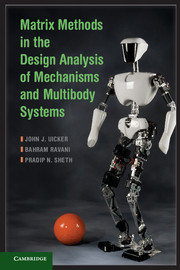Book contents
- Frontmatter
- Contents
- Preface
- About the Authors
- 1 Concepts and Definitions
- 2 Topology and Kinematic Architecture
- 3 Transformation Matrices in Kinematics
- 4 Modeling Mechanisms and Multibody Systems with Transformation Matrices
- 5 Posture Analysis by Kinematic Equations
- 6 Differential Kinematics and Numeric Solution of Posture Equations
- 7 Velocity Analysis
- 8 Acceleration Analysis
- 9 Modeling Dynamic Aspects of Mechanisms and Multibody Systems
- 10 Dynamic Equations of Motion
- 11 Linearized Equations of Motion
- 12 Equilibrium Posture Analysis
- 13 Frequency Response of Mechanisms and Multibody Systems
- 14 Time Response of Mechanisms and Multibody Systems
- 15 Collision Detection
- 16 Impact Analysis
- 17 Constraint Force Analysis
- Index
- References
2 - Topology and Kinematic Architecture
Published online by Cambridge University Press: 05 April 2013
- Frontmatter
- Contents
- Preface
- About the Authors
- 1 Concepts and Definitions
- 2 Topology and Kinematic Architecture
- 3 Transformation Matrices in Kinematics
- 4 Modeling Mechanisms and Multibody Systems with Transformation Matrices
- 5 Posture Analysis by Kinematic Equations
- 6 Differential Kinematics and Numeric Solution of Posture Equations
- 7 Velocity Analysis
- 8 Acceleration Analysis
- 9 Modeling Dynamic Aspects of Mechanisms and Multibody Systems
- 10 Dynamic Equations of Motion
- 11 Linearized Equations of Motion
- 12 Equilibrium Posture Analysis
- 13 Frequency Response of Mechanisms and Multibody Systems
- 14 Time Response of Mechanisms and Multibody Systems
- 15 Collision Detection
- 16 Impact Analysis
- 17 Constraint Force Analysis
- Index
- References
Summary
Introduction
In order to make a systematic study of mechanisms and multibody systems and to develop general methods for their analysis by digital computer, we must be able to recognize and precisely describe certain basic information that governs their operation. For example, it is clear that, at some point, we must explicitly identify certain dimensional information, such as part shapes and dimensions, in order to perform the analysis. However, before we reach this stage, another even more fundamental problem confronts us. We must first study each system enough to determine how its various parts are interrelated – that is, which part is connected to which, and what is the nature of each connection. In other words, we need to understand the kinematic architecture of the multibody mechanical device. In the kinematics literature, the term “structural analysis” has sometimes been used for this type of analysis. Here, however, we use the term “kinematic architecture” to avoid confusion with the statics use of structural analysis.
In the classic methods of analysis, both graphic and analytic, the task of recognizing the architecture of a mechanism or multibody system did not require reduction to a step-by-step procedure. No real difficulties arose because the analyst, through experience, developed an intuitive feeling for analyzing problems of a given type. As the analysis progressed, he or she could continually make decisions based on experience as to what steps should be taken in what order and what techniques might be applied to accomplish each step.
- Type
- Chapter
- Information
- Publisher: Cambridge University PressPrint publication year: 2013



